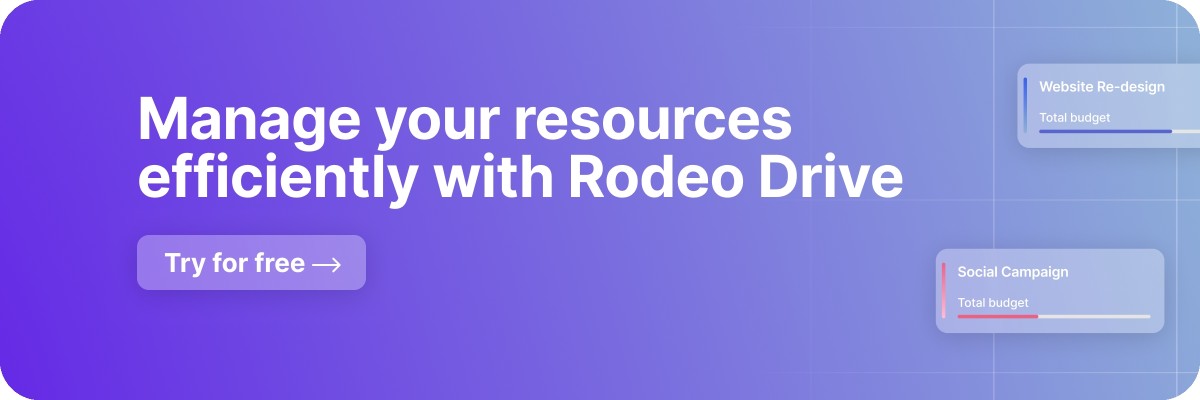10 Tips for Successfully Overcoming Resource Constraints
All projects will encounter constraints. In a world where time and funding are limited, how you choose to spend those valuable resources matters a lot.
The reality is, all projects will encounter resource constraints to some degree. Because projects are temporary, they all happen on a limited timeline, which poses a constraint in and of itself. Limited labor, funding, and other resources are other common obstacles most project teams will have to overcome.
But in cases of resource mismanagement, resource constraints will be far more difficult to overcome. This is why it’s important to familiarize yourself with the ins and outs of resource management ahead of time.
What’s a resource constraint in project management?
In short, a resource constraint is a situation in which the project manager or project team doesn’t have the resources they need to fulfill the expected project outcomes. A constraint might look like a deficit or other limitation that negatively impacts the availability and accessibility of team resources.
During the project planning process, you’ll make assumptions about the amount of resources needed, but resource constraints arise when your assumptions are incorrect or if expectations change, and you end up needing more resources than you initially anticipated.
While your resource planning should account for potential resource constraints, you can’t perfectly expect the unexpected, which is why it’s crucial to familiarize yourself with strategies to use for overcoming these obstacles.

The different types of resource constraints
There are several different types of resources, and any of them can face constraints. This includes intangible and tangible resources like labor, materials, funding, and time — for starters.
All of these resource constraints typically fall into one of four categories: time, cost, scope, or quality. Let’s take a deeper look at each.
Time constraints
Time constraints occur when there is a limited availability of time needed to complete project objectives and fulfill deliverables.
For example, if seven weeks have been allocated for a project’s completion, but the project is running behind and is on track to be completed in 10 weeks instead, then there is a time constraint at play.
Time constraints can occur for a couple of reasons. This might be because the deadlines set by the client are unrealistic, or because the project scope or budget is not aligned with the expected timeline.
Cost constraints
Oftentimes, the cost constraints your project faces are an important determinant of project success. This is because your project budget impacts the availability of all project resources. For instance, if you don’t have the funding to pay for materials or labor hours, then your project won’t get completed.
You might think that your project costs will perfectly align with what you’ve budgeted for, but it’s easy for overspending to cause you to veer off track.
Scope constraints
Your project scope defines your project’s boundaries, including the goals, objectives, and deliverables that your project will encompass. However, your scope can also cause constraints, potentially limiting what falls under your team’s purview.
Scope changes can have an impact on the availability of other resources, as suddenly being asked to deliver more work than previously expected can derail your schedule and budget.
To prevent scope constraints, it’s crucial to clearly document your project scope right from the beginning and ensure that it's agreed upon by all stakeholders.
Related: Project Documentation: How Doing It Right Minimizes Risk
Quality constraints
All project leaders strive to deliver high-quality project outcomes, but when your team is stretched too thin, this isn’t always possible.
For instance, you may face quality constraints when you’re expected to produce project outcomes within a limited time frame. You might be able to produce the requested deliverable, but it won’t be as high quality if it’s produced with half of the team size needed.
You might encounter quality constraints if the client has strict quality standards that your team doesn’t have the resources to meet. Alternatively, you might face quality constraints as a result of your team or organization’s internal quality standards.
What’s the iron triangle?
The iron triangle helps project managers visualize the relationship between the triple constraint, which is scope, time, and cost. The relationship between these three project management constraints requires balance, as a change to one will also impact the other two.
For example, speeding up a project timeline by onboarding an additional team member will consequently drive up the cost of the project. Or perhaps your stakeholders want to expand the project scope — this will require a longer timeline and likely additional funding.
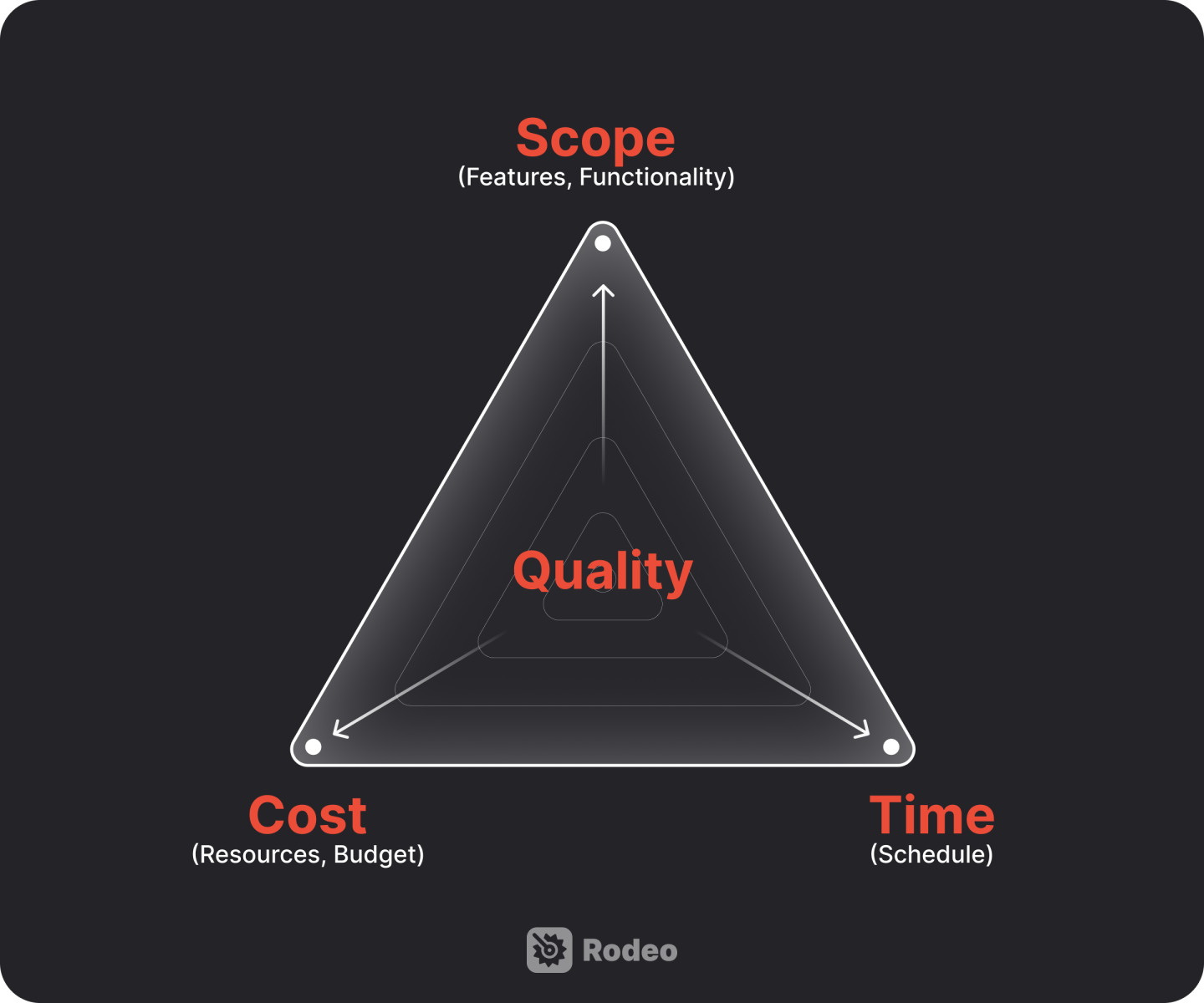
The quality of your project outcomes is usually dependent on the balance you achieve between these three constraints, which is why quality exists at the center of the triangle.
The main takeaway here is that resource constraints don’t exist in a vacuum. More often than not, they’re related to one another. The goal is to make trade-offs that balance these project needs as evenly as possible.
10 tips to manage and overcome resource constraints
Resource constraints are overwhelmingly a negative thing for your project, as constraints in one resource area may impact your decision-making. For instance, when facing a time constraint, the project manager may begin making decisions that prioritize speed over high-quality work.
The best-case scenario is avoiding resource constraints altogether, although this isn’t always possible. Here are 10 tips for managing resource constraints to the best of your abilities.
1. Create a contingency plan
While resource constraints should be considered during the resource planning process, it’s wise to always have a contingency plan in place too.

Your contingency plan serves as a plan B for a project, detailing what steps your team will take if an unexpected event occurs. By preparing for worst-case scenarios ahead of time, you’ll be able to act faster during times of uncertainty.
This is different from a risk management plan, which focuses on risk prevention. Instead, your contingency plan outlines what everyone’s role will be as an urgent event unfolds. This way, you can prevent the event from derailing your project.
Related: What is Project Risk? A Complete Guide [Free Templates]
2. Check the resource allocations of similar previous projects
When working on a new project, there’s a lot that you can learn from similar previous projects your organization has completed. Because chances are, the project management constraints that the project encountered will be similar to those your team will run into.
This is especially true of projects on behalf of the same client. If a very similar project for the same client last year encountered time constraints due to scope creep, you may want to factor this resource constraint into your project plans.
3. Understand stakeholder expectations
As we’ve already discussed, an expansion of your project scope is one of the main causes of resource constraints. If your stakeholders suddenly want the project to include a whole list of additional requirements, then chances are that the project will require more time and funding.
This is why it’s important to clarify stakeholder expectations from the very beginning — especially their expectations regarding scope.
You may also want to gauge their level of flexibility related to resource allocation. For instance, if it seems like your stakeholders might add additional project requirements later on, do they seem willing and able to provide additional resources to meet those needs?
4. Prioritize the parts of your project that need resources most
When managing a limited pool of resources, prioritization is the most important skill to have. Without a system of prioritization, it can be impossible to determine which project needs are most deserving of resources.
To create a system of prioritization, consider which activities your project can’t move forward without, versus which are just nice to have. You might begin implementing this by labeling your project tasks as low, medium, or high priority.
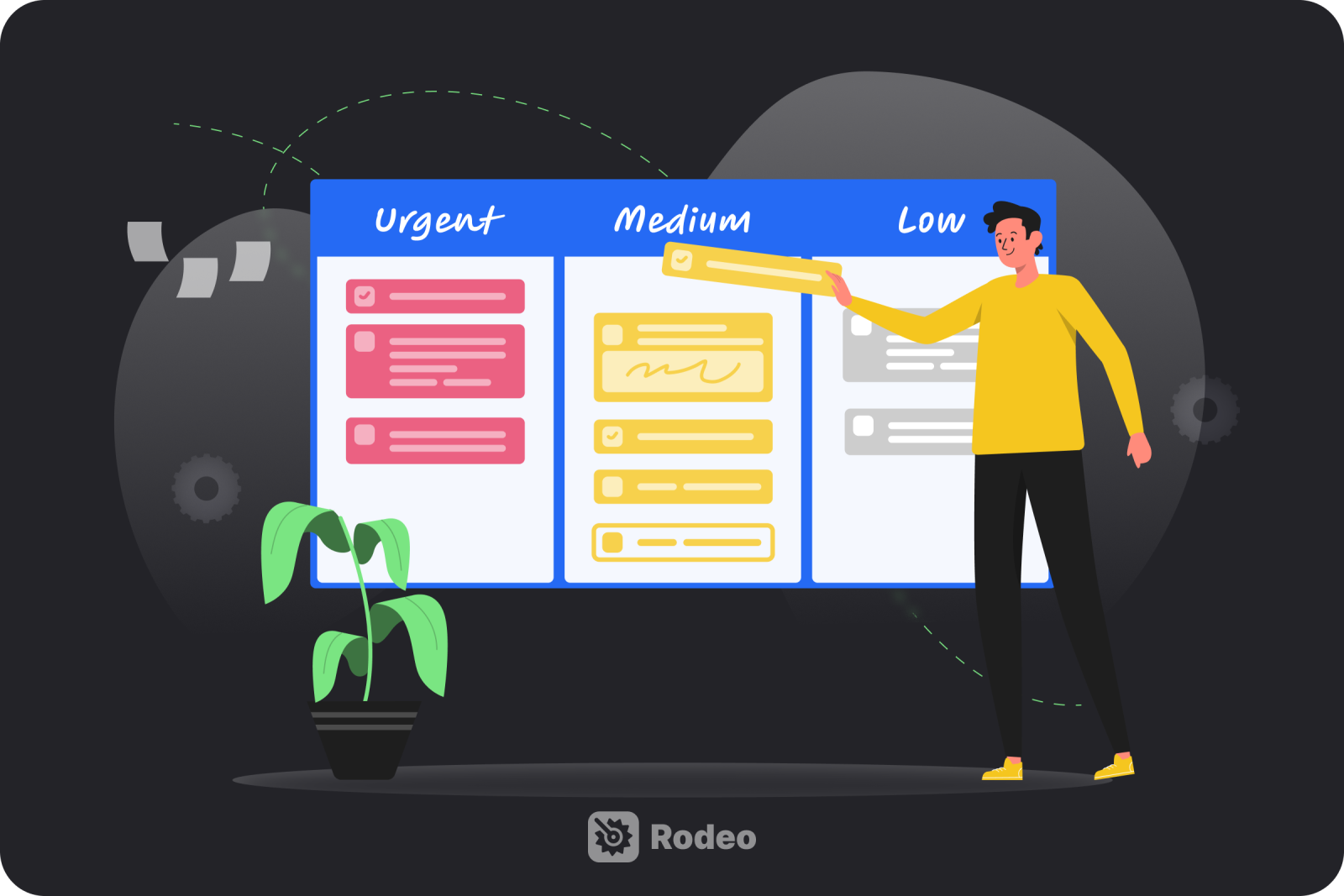
For example, in software development, the team leader must prioritize critical bugs that hurt the core functionality of the product over cosmetic updates that might look nice but have a very limited impact on the software’s usability.
5. Improve your team’s time management
If your team frequently struggles with time constraints, then poor time management might be to blame. Eliminating wasted time can improve your team’s efficiency and ensure all time is properly allocated.
One way to do this is by implementing time tracking. Time tracking is the process of meticulously recording your working hours for better efficiency and easier billing.
Software tools like Rodeo Drive make time tracking easy for teams and make it simple for project managers to have an at-a-glance understanding of employee productivity.

Rodeo Drive’s live timer, which allows you to record hours as you work
Another strategy for improving team time management is time blocking, which is the process of allocating time on your calendar for every task on your to-do list. By scheduling out your day like this, you’re better positioned to overcome time constraints.
6. Monitor resource utilization
Resource utilization is a great way to track the success of your resource planning by measuring how much of an employee’s time is being billed directly to the client.
An individual’s utilization rate is calculated by dividing the number of total billable hours by the total available hours. A high utilization rate means that your team members are spending most of their time on billable work that the client is directly paying for.
On the other hand, a low resource utilization rate suggests that your team members may not be spending enough time on billable project activities, which may impact your project profitability or the way you allocate resources.
7. Consider resource sharing
If your agency or organization has several ongoing projects at one time, other projects may have a surplus of resources that your team is lacking. When this happens, sharing resources across projects is a great way to overcome resource constraints.
So, for example, if a different project team can lend you extra materials or an extra set of hands, you may find yourself able to overcome quality constraints that you’d otherwise be left struggling with.
8. Reassign work when necessary
Properly managing your team’s workload capacity is a key part of avoiding and overcoming resource constraints.
Having too many project activities assigned to one person can cause bottlenecks. Instead, reassigning those tasks to a team member with more capacity can eliminate issues posed by time constraints.
Software tools with task and activity planning functionality can help you keep better track of what everyone’s working on, making it easy to prevent burnout and guarantee that everyone delivers their work by the deadline.
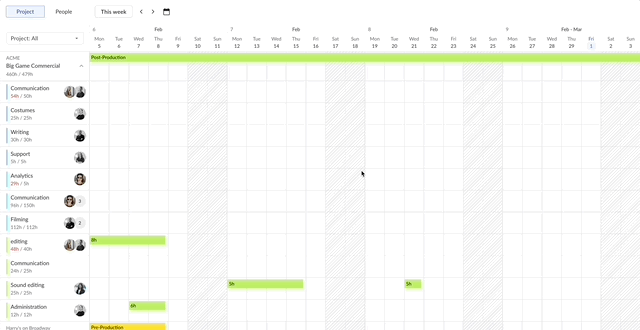
Rescheduling tasks is simple and easy using Rodeo Drive’s timeline-view planner
Some teams turn to outsourcing as another solution to overcoming resource constraints. For example, your company might enlist the help of a temp worker agency if your project doesn’t have enough manpower to be successfully completed. However, onboarding external workers to new projects can be time-consuming and challenging.
9. Adjust your resource allocations as necessary
In a project with multiple stages or phases, you may realize early on that your resource allocations are off. If this happens, you’ll need to rethink your distribution to avoid resource constraints.
For instance, if you’re working on a video project and realize that the amount of work you planned in the pre-production phase exceeded the amount of manpower required, then you may want to proactively add additional freelancers or other team members to your later project stages before it’s too late.
10. Implement a resource management software
At the end of the day, managing resource constraints is easier with the help of a resource management tool. Typically, resource management software tools offer visibility into your team’s time, capacity, budget spending, and performance.
Rodeo Drive offers these capabilities, in addition to several other financial-focused features that boost profitability and ensure consistent results. Let’s take a closer look at what Rodeo Drive can provide:
Assign work through your timeline-view activity planner
Some resource constraints arise due to poor visibility of team capacity. That’s why Rodeo Drive offers a timeline-view planner that enables you to plan your team’s project activities so that no one is stretched too thin.
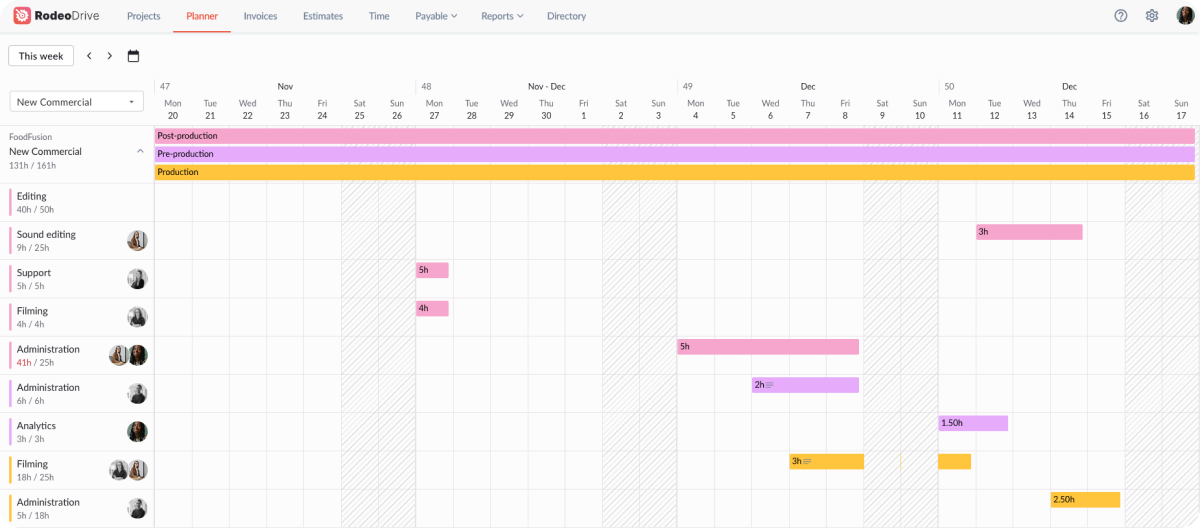
Rodeo Drive’s timeline view project activity planner
This way, before scheduling new project activities, you can check what’s on each team member’s plate, as well as how many free hours they have to take on additional work. Avoiding time constraints has never been easier.
Track time in convenient ways
When time constraints do arise, you’ll find that time tracking is a great way to get to the root of the problem and determine what’s eating up so much of your team’s time.
Rodeo Drive enables your team to track time in whatever way is most convenient. Users can start their live timer when they begin working on a project activity, or they can add a timecard after the activity is complete.
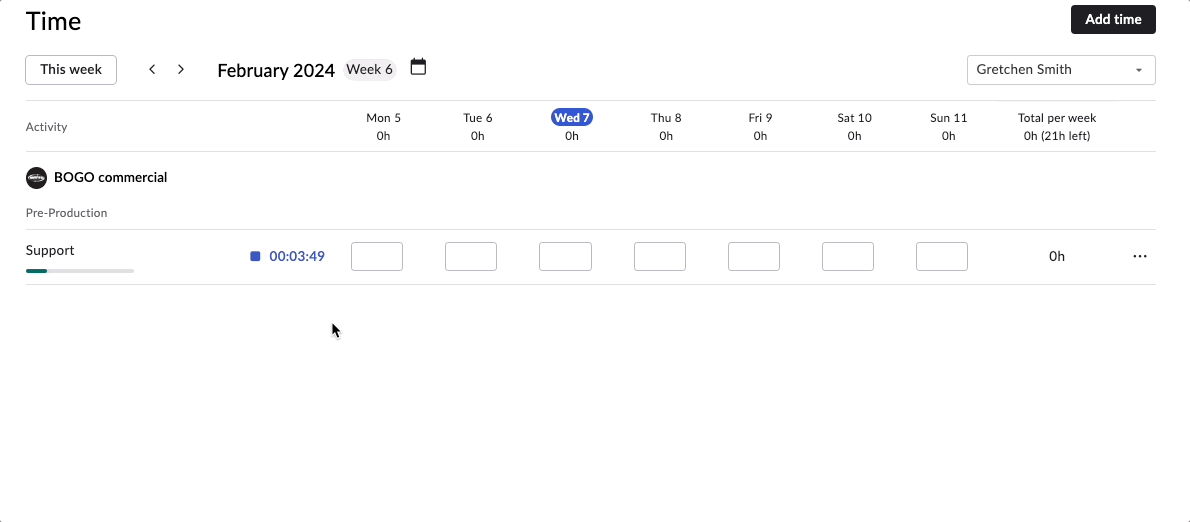
Stopping your time-tracking stopwatch in Rodeo Drive
Access insights into your team’s performance with auto-generated reports
Rodeo Drive offers access to three automatically generated project reports based on your team’s usage of the platform. This includes reports on time, productivity, and projects — which offers a holistic look at your profitability and financial performance.
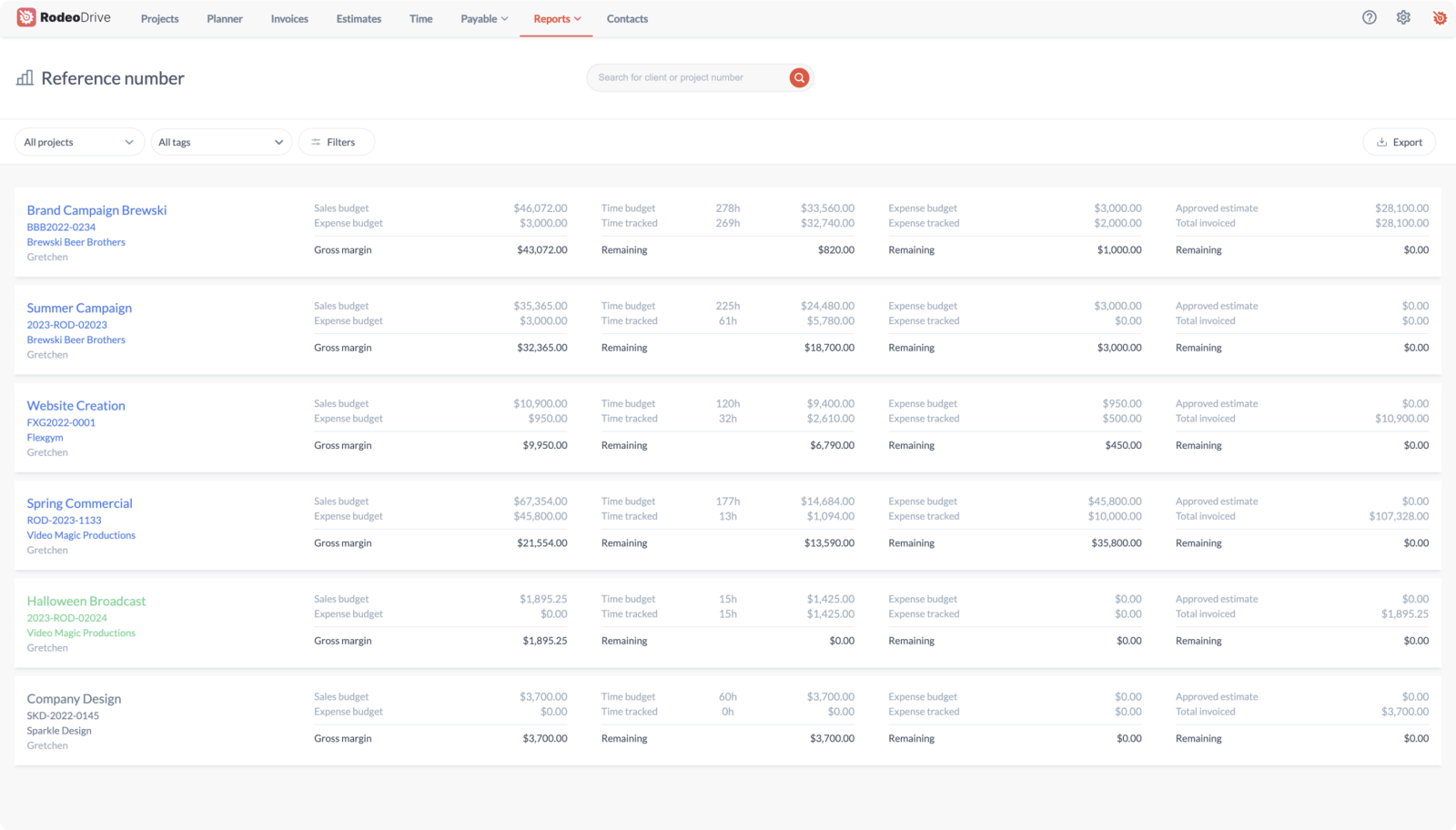
Rodeo Drive’s Projects report automatically calculates your project profitability
Why wait? Try Rodeo Drive for free today — you won’t even need to enter a credit card to get started.





